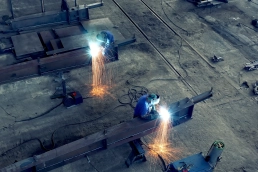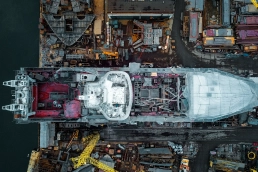Navigating Shipyard Fire Safety Using Wireless Protection
There is a significant risk of fire around shipyards and shipbuilding operations, yet finding solutions that fit the unique requirements can be challenging. The maritime industry demands comprehensive safety measures to detect and prevent fires in these environments, but many argue that current methods are outdated and in need of improvement. In this article, we explore the challenges and what is needed to revolutionize fire protection for shipyards.
While there is no question that fire poses a huge threat to ships and boats at sea, it is perhaps less known about the risks on land. As with any active construction site, there are multiple potential hazards around these heavy industrial areas, with additional challenges due to their location and specification. Studies conducted by the International Association of Classification Societies (IACS) reveal that fire incidents occur more frequently in these environments than many realize. The U.S. Government Accountability Offshore (GAO) has also recently called on the U.S. Navy to enhance its safety efforts, highlighting the lack of standardized evaluation and learning of fire safety.
The GAO produced a study in response to the more than $4 billion in estimated damages from ship fires during maintenance from May 2008 to December 2022, which included the loss of the USS Bonhomme Richard. Following this study, the GAO made three recommendations to the US Navy to effectively learn from these disasters, analyze the effects and set service-wide goals. These incidents emphasize the urgent need for advanced fire protection measures in shipyards and shipbuilding processes.
A complex environment
It is widely known within the ship building industry that ship maintenance is a major cause of fires after several reports in recent years. In 2012, a fire on USS Miami led to its premature decommission after repair costs soared to an estimated $700 million. Then USS Oscar Austin suffered a fire during maintenance in 2018 that delayed its return to fleet. In 2019, the commanding officer of the USS Fitzgerald criticized the Ingalls shipbuilding yard for more than 15 fire safety incidents as part of a monthly status report, where the lack of fire safety was described as ‘a major concern’ on the pathway that could lead to a ‘catastrophic fire event on board’. The causes are often linked to the quantity of ‘hot work’ taking place around highly flammable material. This includes welding, grinding and cutting of steel with torches, causing open flames and free-flying sparks.
Combustible materials are abundant on shipyards and on vessels, including the storage of fuel, lubricants, paints and solvents. Add to this the high level of cargo, wooden structures, building materials and litter, and the ability for fire to spread quickly increases. There are also sophisticated electrical systems in place on ships and throughout shipyards, which means there is potential for electrical malfunctions that could lead to a fire.
The overall nature and design of shipyards also lends itself to being difficult for fire detection, suppression and evacuation. There are many tight compartments and confined spaces on ships and difficult areas to navigate around the vessel, often comprising steep walls, ladders, uneven surfaces and proximity to open water. Health and safety measures covered by the US’ Occupational Health and Safety Administration (OSHA), which must be adhered to, and breaching these regulations can be damaging for projects and owner reputation.
Searching for solutions
Historically, fire safety within ship building has been a problem with no real solutions. Typically, a fire safety plan is put in place on ship building sites with various preventative methods and risk assessments to understand where a fire could occur.
Manual fire watches are also in place to monitor operations and alert in the case of an emergency. This of course is a costly and physically demanding task that is also susceptible to human error. Within shipyards, the environments are also prone to loud noises and hazardous distractions, making alerts more difficult to get across.
In addition, automated fire safety systems are used to trigger evacuation and fire suppressants through various sensors such as smoke detectors. Often these systems are outdated, however, with wires that can be accidentally cut by contractors and are often costly to install and maintain. Because of the complexities of a shipyard’s layout, wired systems are also limited by where they can be used and may not be able to reach places that require monitoring.
A new horizon for fire safety
To effectively address the fire risks in shipyards and during shipbuilding, it is essential that the industry looks at new and innovative measures alongside enhanced training and planning. One of the ways this could be achieved is through wireless systems that are able to address the current issues faced with shipyards. By removing the need for installation of permanent wiring, sites are able to be more effectively monitored with comprehensive coverage. By using temporary units that can be placed across the vessel and its surroundings, there is the potential to detect smoke, heat and flames in any corner of the environment. These units are then able to send out alerts to instigate reaction and evacuation, keeping teams and sites safe.
Ramtech’s WES3 system is a good example of this and has been effectively used in shipyards to provide 24/7 peace of mind. Coupled with a notification system, such as Ramtech’s REACT, real-time alerts can be passed through the WES units to mobile devices whenever and wherever needed, prompting a rapid response and giving personnel eyes on the site even when absent. In addition to these revolutionary systems, bolstering safety training and protocols must be made a priority, to emphasize how fire can be prevented or adequately controlled, protecting life and property.
This could be done through independent training regimes and emergency response plans that are tailored to each specific shipyard or vessel – these would need to be routinely practiced ensuring they are robust. But perhaps what is needed for the industry is a collaborative effort to bring about industry-wide standards that allow for all shipyards to follow best practice.

